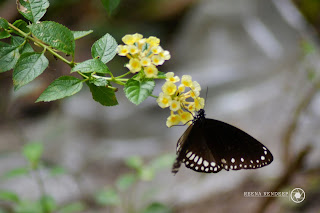Common Crow (Euploea core)
The common crow is a glossy-black butterfly with brown undersides having white markings along the outer margins of both wings. In India it is also sometimes referred to as the common Indian crow. It is a common butterfly found in South Asia to Australia.
The adult butterfly is easily recognized by its dark brown wings that are spotted white along the margins. The male's forewing has a bow-shaped hind margin, while the female's is straight.
The adult butterflies only have four normal legs, as the first pair of legs is not fully developed (a common feature of the Family Nymphalidae).
The Common Crow Butterfly has a strong scent that may allow predators to identify it as inedible. It also produces (from chemicals in its food plants) toxins so strong that eating just one butterfly may induce a bird to vomit.
The adult butterfly has a life span of 11 - 13 weeks. The adults feed upon nectar from various flowering plants, including eucalypts.
The Common Crow Butterfly has a very slow, gliding style of flight. It is usually seen flying within a few meters of the ground.
It belongs to the crows and tigers subfamily Danainae
References :
https://australian.museum/
Wikipedia
pictures:
Kerala (2018, 2019)




















































